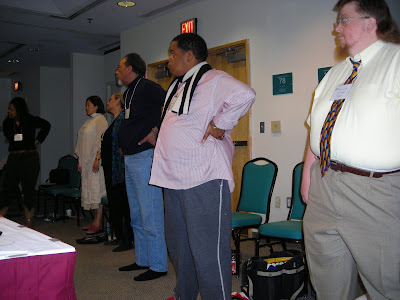

(Wall Hangings in the Boudoir of an African Princess -picture taken by Qiyamah A. Rahman
Welcome, traveler! Enter and take your rest in the Chaikhana. What is a chaikhana. It is a teahouse along the legendary Silk Road pilgrimage and trading route linking China to the Middle East and Europe. It is a place of rest along the journey, a place to shake off the dust of the road, to sip tea, and to gather together to sing songs of the Divine...
(excerpted from: Poetry Chaikhana at www.Poetry-Chaikhana.com)
Sarmad, or Hazrat Sarmad Shaheed, is a fascinating and complex character who seems to have bridged several cultures in Persia and India. Apparently, Sarmad originally lived in an Armenian community in Iran. Some believe that Sarmad was from a Jewish background, earning him the modern epithet of the Jewish Sufi Saint of India. Other scholars suggest he was Christian before taking up the Sufi path.
He had an excellent command of both Persian and Arabic, essential for his work as a merchant. Hearing that precious items and works of art were being purchased in India at high prices, Sarmad gathered together his wares and traveled to India where he intended to sell them.
Near the end of his journey, however, he is said to have fallen in love with a dervish boy. This ardent love ('ishq) created such a radical transformation in his awareness that Sarmad immediately dropped all desire for wealth and worldly comfort. In this ecstatic state, he even lost all concern with social convention and began to wander about without clothes, becoming a naked faqir.
He continued journeying through India, but now as a naked dervish rather than as a merchant. He ended up in Delhi where he found the favor of a prince in the region and gained a certain amount of influence at court. That prince, however, was soon overthrown by Aurengzeb, who saw the naked Sarmad as a political enemy. Sarmad was eventually accused of political crimes and unorthodox Muslim practice, and Sarmad was eventually put to death.
The following account provides more detail about the interaction between Hazrat Sarmad Shaheed and his final demise at the hands of his adversaries:
His entry into Delhi
He reached Delhi in this state of nakedness. Prince Dara Shikuh was Sufi-orientated and a friend of fakirs. When he discovered that Sarmad had entered Delhi he ensured that he became acquainted with the Shaykh very soon. After he got to know the Shaykh closely, he was greatly affected by his spiritual power. He respected the Shaykh very much. Prince Dara Shikuh was one of his admirers. Thus he became to have much influence at court.
A change of government
Prince Aurangzeb defeated Dara Shikuh and took the reigns of power into his own hands in lieu of Shah Jahan. Dara Shikuh began to wander from desert to desert and settlement to settlement. This period was a testing one for Dara Shikuh’s sympathisers, supporters and associates. Hazrat Sarmad was one of these too. Some people had fled with Dara Shikuh and those who remained considered themselves in danger. Hazrat Sarmad chose not to leave as he knew that his burial place would be in Delhi.
Accusations
The accusations which were made upon him were not free from political machinations. The first accusation was that he had apparently rejected the Prophet’s (Allah bless him and give him peace) physical Ascension [mi’raj] in the following quatrain [5]:
Every man who is aware of his secret
He becomes concealed even from the skies
The mullah says that Ahmad [6] went to the heavens
Sarmad says that the heavens were inside Ahmad!
The second accusation made upon him was that he was a sympathiser and well-wisher of Dara Shikuh. The third was that he was always nude which is against the teachings of the Shar’iah. The fourth accusation was that he did not read the full kalimah and only recited the words, “There is no god ” [7].
His replies
Aurangzeb sent the Chief Justice Mullah Qavi to Hazrat Sarmad to question him about why he remained naked. When Mullah Qavi asked him the reason as to why he remained naked he recited the following quatrain:
He is happy on account of my humble self
Evil eye and wine is stolen from my hands
He is in my bosom; search for Him in me!
Tis strange that a thief has caused me to be naked!
He was summoned before the court. In this gathering there were the greatest scholars and divines present too in addition to Aurangzeb. Aurangzeb asked him, “People say that you gave Dara Shikuh the good news of the sultanate. Is this true?” Hazrat Sarmad replied, “Yes it is true; and that good news was truthful for he has attained the crown of the eternal sultanate.” The scholars asked him, “Why do you roam around naked?” He gave the same reply which he had given earlier to Mullah Qavi. The scholars asked him to put on some clothes but he ignored them [8] . Aurangzeb addressed the scholars and said, “Being naked in itself is not a reason to kill someone. Ask him to recite the first kalimah.” Sarmad was asked to recite the kalimah. As per his habit he only recited, “There is no god”. When the scholars heard these words of negation they were extremely annoyed. He replied, “Presently, I am drowned [mustaghraq] in Negation [9] ; I have not yet reached the (spiritual) station of Affirmation yet. If I read the full kalimah in this state, I will be telling a lie.” The scholars decided that this action of his was blasphemy [kufr] and that repentance was necessary. Hazrat Sarmad refused to repent. The scholars decided that the death penalty was permissible in this case.
The next day he was taken to the execution spot. When the executioner came near to him with a gleaming sword in his hand, he smiled on seeing him and then lifting his eyes to the heavens spoke these historic words:
“May I be sacrificed for you! Come, come, for whichever guise You come in, I recognise You!” Then he recited this distich:
There was a commotion and I opened my eyes from the dream of Non-Existence
I saw that the night of sedition still remained, and so went back to sleep!
After reading this verse he presented his neck and drank from the goblet of martyrdom. His martyrdom occurred in the year 1070 A.H.
His shrine is beneath the Jamia Masjid in Delhi and a fount of blessings and grace.
Hazrat Sarmad was a perfect intoxicated [majzub] saint. He had no equal in his Islamic knowledge and virtues. Many people were his followers and disciples. His letters, which are known by the title, “Ruqa’at e Sarmad” [Epistles of Sarmad] are a testimony to his knowledge. He also wrote many quatrains [rubai] in Persian and these are famous as Rubaiyyaat e Sarmad (Quatrains of Sarmad). These have been published. Two of his most famous quatrains are given below and are a representation of his thought and ideas:
O’ Sarmad the pain of love is not given to slaves of their desires
The burning of the moth’s heart is not given to the honey-bee!
A whole lifetime is required to obtain Union with the Friend
This treasure, Sarmad, is not given to one and all!
***
I have been honoured with the office of Love
I have been made oblivious to asking from creatures
Like a candle have I been melted in this world
Due to my burning have I been made a confidante!
Miracles
After his martyrdom the words, ”There is no god but Allah” were heard from his mouth thrice. Not only did his severed head recite the kalimah but it continued to praise Allah Almighty for some time afterwards. Aurangzeb ruled for nearly 48 years after Hazrat Sarmad’s martyrdom but never achieved peace and tranquillity. He spent a long time fighting in the Deccan and finally died there.
The following poems,all separately titled and separate poems represent a small sampling of Hazrat Sarmad's poetry:
CompanionAlong the road, you were my companion
Seeking the path, you were my guide
No matter to whom I spoke, it was you who answered
When Sun called Moon to Sky, it was you who shined
In the Night of aloneness, you
were my comforter
When I laughed, you were the smile on my lips
When I cried, you were the tears on my face
When I wrote, you were the verse
When I sang, you were the song
Rarely did my heart desire another lover
Then when it did, you came to me in the other.
Every Man Who is Aware of His Secret Every man who is aware of his secret
He becomes concealed even from the skies
The mullah says that Ahmad went to the heavens
Sarmad says that the heavens were inside Ahmad!
To the Dignified Station of Love Was I RaisedTo the dignified station of love I was raised,
And from the favours of the people I was freed.
Like a candle I was melted in this assembly,
By being burnt, in the divine mysteries I was initiated.
This next poem, unlike the previous ones were written by the poet, Dariya Sahib. Sant Dariya Sahib of Bihar was born in India at a time when the power of the Muslim Mughals was declining and the British had not yet fully asserted their power over the region. It was an era of many petty rulers and warlords and general social turmoil and religious strife. Sant Dariya emerged as a poet-saint who encouraged harmony between Hindus and Muslims. He received enlightenment at the age of 20, and began to teach a path of non-violence and love for all.As a poet, Sant Dariya composed more than 15,000 verses.In fact, in one of his books, Dariya suggests he was the great poet Kabir in a previous incarnation. There is some disagreement about the years of his life, but many assert he lived nearly 150 years.
You Have Nothing to Worry About You have nothing to worry about.
Be free from worries,
And remain immersed in love for the Beloved.
He shall take you across the ocean of the world,
If you seek support of his boat sailing in this ocean.
No amulet, charm, yogic practice
or other holy repetition is of any avail.
Only he provides the technique which destroys sins,
and removes vices from the heart.
By seeing and reflecting within your heart,
says Daria,
You will be freed from all ills
Just by kindling the wick of Nam
with the Satguru's lamp.
A final poem by Dariy Sahib:
Without Love There Can Be No Devotion and Wisdom (from Love Chapter)Sant Dariya Sahib of Bihar was born in India at a time when the power of the Muslim Mughals was declining and the British had not yet fully asserted their power over the region. It was an era of many petty rulers and warlords and general social turmoil and religious strife.
Sant Dariya emerged as a poet-saint who encouraged harmony between Hindus and Muslims.
He received enlightenment at the age of 20, and began to teach a path of non-violence and love for all.
As a poet, Sant Dariya composed more than 15,000 verses.
In fact, in one of his books, Dariya suggests he was the great poet Kabir in a previous incarnation.
There is some disagreement about the years of his life, but many assert he lived nearly 150 years.





























